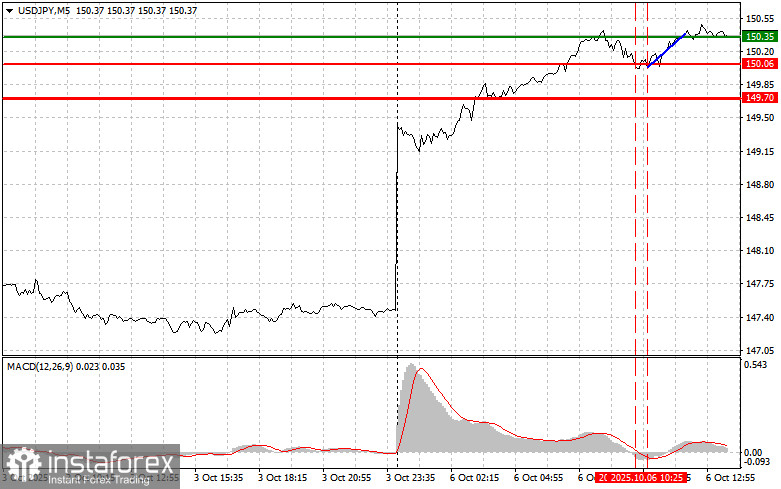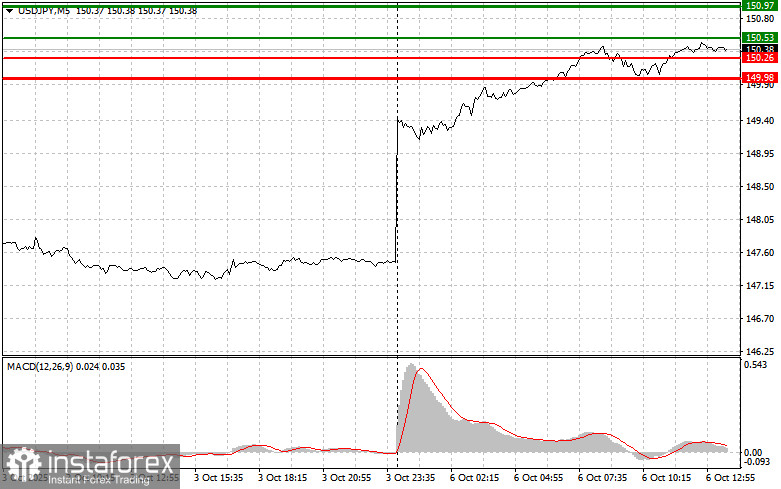Trade analysis and recommendations for trading the Japanese yen
The test of the 150.06 level in the first half of the day occurred when the MACD had already moved far below the zero mark, which, in the context of such a strong uptrend, limited the pair's downward potential. The second test of 150.06, when the MACD was in the oversold area, allowed Scenario #2 for buying to play out, resulting in a rise of more than 40 points.
In the second half of the day, no U.S. data is expected, so pressure on the yen may persist, especially after the news about who became the new Prime Minister of Japan. The market is closely watching every detail in an effort to assess possible changes in monetary policy and fiscal stimulus that the new head of government may propose. Any signal of a potential shift away from the currently restrictive policy of the Central Bank could cause a sharp fall in the yen.
This morning, the almost guaranteed appointment of Sanae Takaichi as Japan's next prime minister shook the country's financial markets, as traders bet that she would adopt additional measures to stimulate the economy. The yen lost 1.8% against the dollar, surpassing 150 points, and reached a historic low against the euro.
As for the intraday strategy, I will rely more on the implementation of Scenarios #1 and #2.

Buy Signal
Scenario #1: Today, I plan to buy USD/JPY around the entry point of 150.53 (green line on the chart) with the goal of rising to 150.97 (thicker green line on the chart). Around 150.97, I will exit long positions and open shorts in the opposite direction, expecting a movement of 30–35 points in the opposite direction. Further growth of the pair can be expected in continuation of the morning trend. Important! Before buying, make sure the MACD indicator is above the zero mark and just starting its upward movement.
Scenario #2: I also plan to buy USD/JPY today if the 150.26 level is tested twice in a row, at the moment when the MACD indicator is in the oversold area. This will limit the pair's downward potential and lead to a market reversal upward. Growth toward the opposite levels of 150.53 and 150.97 can be expected.
Sell Signal
Scenario #1: Today, I plan to sell USD/JPY after breaking below the 150.26 level (red line on the chart), which should lead to a rapid decline in the pair. The key target for sellers will be 149.98, where I plan to exit shorts and immediately open longs in the opposite direction, expecting a 20–25 point move upward from that level. Pressure on the pair may persist if weak data emerges. Important! Before selling, make sure the MACD indicator is below the zero mark and just starting its downward movement.
Scenario #2: I also plan to sell USD/JPY today if the 150.53 level is tested twice in a row, at the moment when the MACD indicator is in the overbought area. This will limit the pair's upward potential and lead to a downward reversal. A decline toward the opposite levels of 150.26 and 149.98 can be expected.

On the Chart:
- Thin green line – entry price for buying the trading instrument.
- Thick green line – estimated price where Take Profit can be set, or profit can be taken manually, since further growth above this level is unlikely.
- Thin red line – entry price for selling the trading instrument.
- Thick red line – estimated price where Take Profit can be set, or profit can be taken manually, since further decline below this level is unlikely.
- MACD indicator – when entering the market, it is important to use overbought and oversold zones as guidance.
Important Note for Beginners:
Beginner traders in the Forex market should be very cautious when making decisions about entering the market. Before the release of important fundamental reports, it is best to stay out of the market to avoid sharp price swings. If you decide to trade during news releases, always set stop orders to minimize losses. Without stop orders, you can very quickly lose your entire deposit, especially if you don't use money management and trade with large volumes.
And remember, for successful trading you must have a clear trading plan, like the one I presented above. Spontaneous trading decisions based on the current market situation are an inherently losing strategy for intraday traders.





















